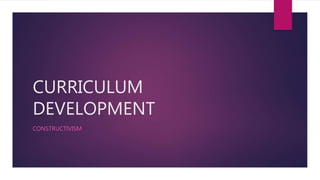
Constructivism and Humanism in Curriculum
- 2. INTRODUCTION The early years are important because it provides the basis for language for language and physical dexterity, social understanding and emotional development for the rest of the child’s life. The child teaches herself by absorbing information and experiencing the world around him. Such learning is the bases of constructivism, an idea that has generated much excitement and interest among educators.
- 3. Constructivism Learning is the active construction of knowledge It is a perspective of learning that has its origins in the works of Bruner, Piaget and Vygotsky. Learners are not passive recipients of information but are active agents engaging in constructing their own knowledge. Assimilation – fitting new experience into an existing mental structure Accommodation – revising an existing schema because of a new experience Equilibrium – seeking cognitive stability through assimilation and accommodation
- 4. Von Glaserfed, 1990 “knowledge is the result of an individual subject’s constructive activity, not a commodity that somehow resides outside the knower and can be conveyed or instilled by diligent perception of linguistics communication”
- 5. Constructivism Inside the Classroom Students should not be treated as passive learners but rather as active learners exploring and going beyond the information given. Authentic settings provide learners with opportunities to see a problem from different perspectives as well as negotiate and generate solutions through sharing and exchange of ideas.
- 6. Constructivism Inside the Classroom Students autonomy and initiative are accepted and encouraged. Higher level of thinking is encouraged. Students are engaged in dialogue with the teacher and with each other. Students are engaged in experience that challenge hypotheses and encourage discussion Curriculum emphasizes big concepts, beginning with the whole and expanding to include the parts
- 7. Learning is a Social Activity Constructivism emphasizes that learning is a social activity. Often it is social experiences, rather than what is taught in schools that accounts for much of the variation in student learning. (Vygostky, 1978) the community is the basic fabric of student learning encompassing the values, beliefs, norms, habits and behaviors of a culture. Within their peer group, young adolescents encounter many new ideas and points of view. Organizing this kind of learning is a much more complex kind of teaching compared to lecturing or demonstrations.
- 8. Zone of Proximal Development It is the range of tasks that the child can perform with guidance from others but can’t perform yet independently. Scaffold – adults’ contributions to children’s learning Support mechanisms that teachers, parents and others provide to help students successfully perform a task within their zone of proximal development
- 9. HUMANISM Refers to a wide variety of ideas and techniques. They all advocate humanizing teaching and learning. The learner is a person who has feelings, attitudes and emotions Stress and constant fear have a profound effect on learner’s ability to think and learn effectively Failure have a major impact on a student’s current ability to learn.
- 10. Abraham Maslow He observed that humans are constantly striving to control their behavior and seeking to gratify themselves. Maslow’s Hierarchy of Needs (1943) Survival needs: food, water, air and rest Safety needs: to be safe and avoid danger Belongingness and love needs: gain affection of people and need to belong to a group Esteem needs: to be recognized and feeling worthwhile Knowing and understanding needs: a desire to know, learn, and understand things Self-actualization needs: to develop one’s full potential and to fulfill one’s aesthetic needs
- 11. Parents and society play a significant role in ensuring that the psychological, safety, love, belonging and esteem needs of children are satisfied. Schools must create an atmosphere of trust, warmth and care.
- 12. Carl Rogers He was a psychotherapist who believed that the client is the most important person and developed what he called client-centered therapy. Client-centered therapy- the therapist was not to tell the client what to do but rather the client should learn how to control his/her own behavior. He proposed that classrooms become learner-centered and teachers should facilitate learning. Let students talk about their feelings and finding ways to vent their emotions productively can help them to learn.
- 13. Arthur Combs He believed that how a person perceives himself or herself is most important and that the basic purpose of teaching is to help each student develop a positive self- concept.
- 14. 6 Characteristics of Good Teachers They are well-informed about their subject They are sensitive to the feelings of students and colleagues They believe that students can learn They have a positive self-concept They believe in helping all students do their best They use many different methods of instruction
- 15. Humanism in the Classroom Establish a warm, democratic, positive and non-threatening learning environment Function as a facilitator The teacher may occasionally shows his or her “real person” Provide learning experiences Teachers as role models Student and teachers plan together Students are given choices and freedom Learning is based on life experiences, discovery, exploring and experimenting